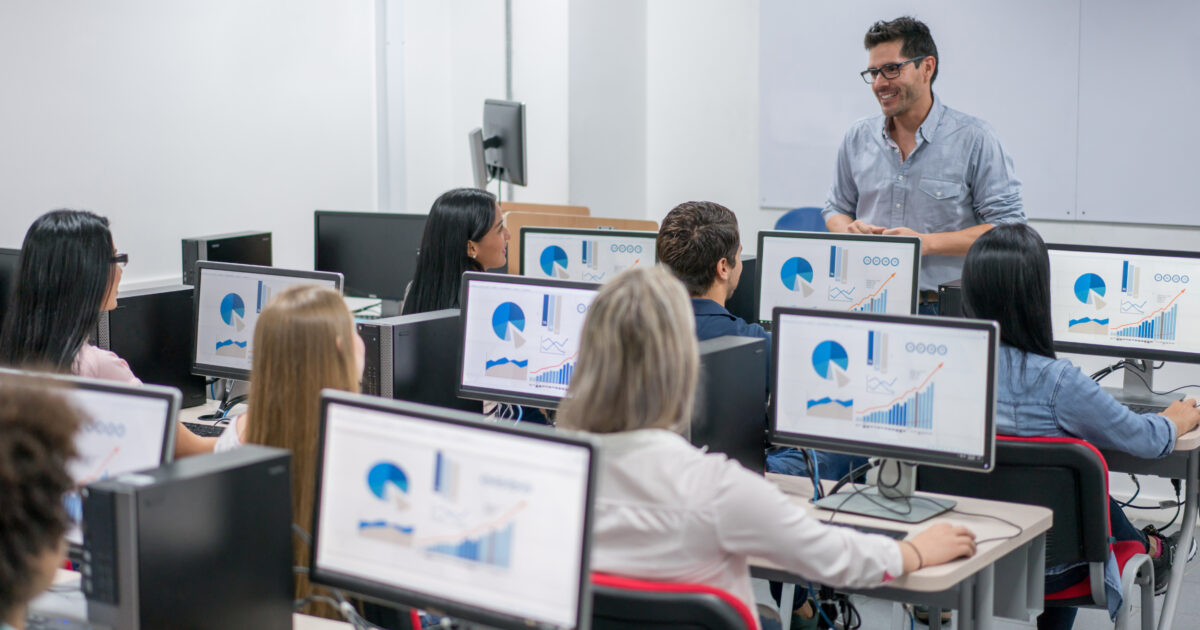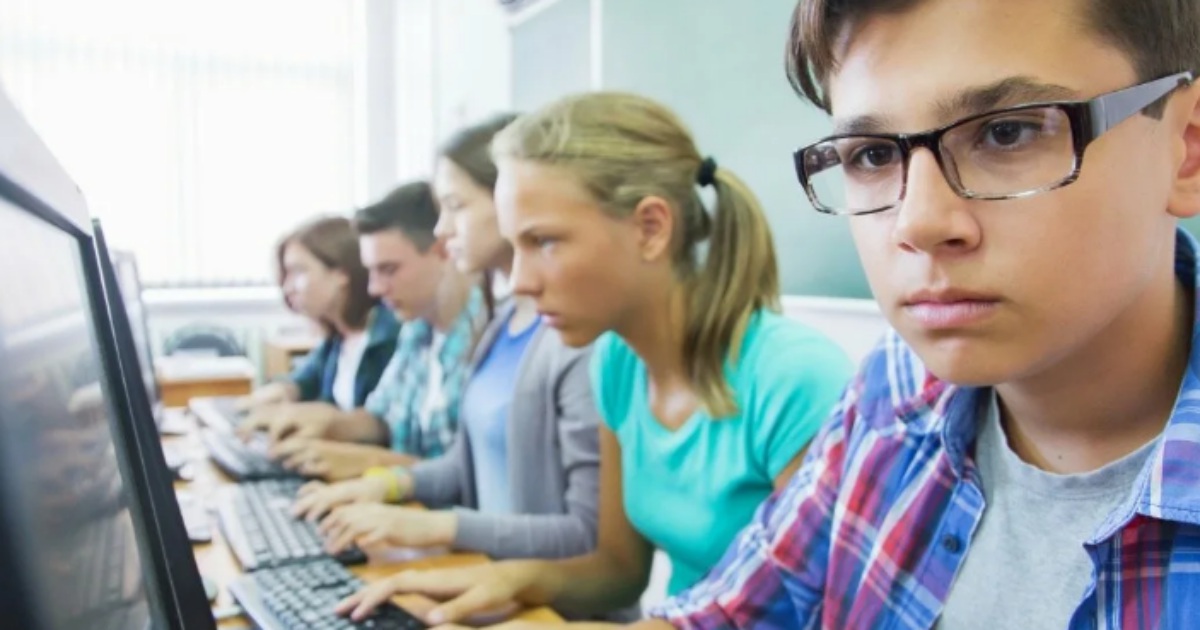Digital Classrooms: Tech’s Impact on Education
In the dynamic realm of education, the advent of the digital age has ushered in a revolutionary transformation, fundamentally altering the landscape of teaching and learning.
The Evolution of Education in the Digital Age
Once confined to the traditional setting of chalkboards and textbooks, education has undergone a profound evolution. The digital age signifies a departure from conventional methods, embracing an era where the transmission of knowledge is not only facilitated by technology but is intricately woven into its fabric.
The Pivotal Role of Technology in Shaping Modern Classrooms
Beyond being a passive observer, technology has become an active participant in the educational process. It’s not merely a tool; it’s a catalyst reshaping classrooms into dynamic environments where interactive learning, innovation, and collaboration take center stage.
The Rise of Digital Learning

The transition from traditional to digital learning isn’t just a paradigm shift; it’s a monumental leap that extends the boundaries of education beyond the physical confines of classrooms.
From Traditional to Digital: A Paradigm Shift
Education, once tethered to brick-and-mortar structures, has transcended spatial limitations. The shift to digital learning signifies a profound transformation, liberating education from geographical constraints and offering boundless possibilities for learners worldwide.
Exploring the Growth of Online Education Platforms
Online education platforms aren’t merely repositories of information; they represent a seismic shift in the way learning is conceptualized. These platforms are dynamic ecosystems, fostering interactive and engaging educational experiences that transcend the limitations of traditional pedagogy.
Interactive Learning Tools
In the digital classroom, learning is no longer a passive absorption of facts but an immersive and engaging experience facilitated by interactive tools.
Gamification in Education: Making Learning Fun
Gamification is not a frivolous addition; it’s a strategic pedagogical innovation. By integrating game elements into the learning process, education becomes not only informative but also inherently enjoyable, enhancing student engagement and knowledge retention.
Virtual Reality (VR) and Augmented Reality (AR) in the Classroom
The integration of Virtual Reality (VR) and Augmented Reality (AR) isn’t a futuristic fantasy; it’s a tangible reality reshaping the educational landscape. These technologies transform classrooms into immersive environments, where abstract concepts come to life, offering students experiential learning opportunities.
Personalized Learning Experiences
Recognizing that one size does not fit all, the digital era champions personalized learning, tailoring educational experiences to individual needs.
Adaptive Learning Systems: Tailoring Education to Individual Needs
Education is no longer confined to a one-size-fits-all approach. Adaptive learning systems dynamically adjust to the unique pace and learning style of each student, ensuring a personalized educational journey.
AI-Powered Tutoring: The Future of Personalized Education
Artificial Intelligence (AI) isn’t replacing human educators; it’s complementing them. AI-powered tutoring systems provide personalized assistance, adapting to individual learning patterns and offering targeted support where needed.
Enhancing Collaboration
The digital landscape redefines collaboration, breaking down geographical barriers and fostering a global community of learners.
Virtual Classrooms: Breaking Down Geographical Barriers
The traditional classroom’s boundaries expand in virtual classrooms, transcending geographical limitations. Students and educators connect, collaborate, and learn together, irrespective of their physical locations.
Online Group Projects: Fostering Collaboration in a Digital Environment
Collaboration isn’t confined to face-to-face interactions. Online group projects create a digital space where students learn the art of teamwork, honing skills crucial for success in the interconnected world.
The Role of Social Media in Education
Social media emerges as a powerful tool in the educational landscape, transforming it into a dynamic and interconnected community.
Leveraging Social Platforms for Educational Purposes
Social media platforms cease to be mere distractions; they evolve into dynamic tools for educational enrichment. Through curated content and discussions, these platforms become valuable resources, facilitating discovery and exploration.
Building Learning Communities: The Power of Online Forums
Online forums aren’t just spaces for idle chatter; they evolve into thriving learning communities. These digital hubs foster the exchange of ideas and collaborative knowledge construction, transcending geographical boundaries.
Accessibility and Inclusivity
Digital education becomes a catalyst for inclusivity, breaking down physical and socio-economic barriers.
Bridging Gaps with Online Education
Online education isn’t just a matter of convenience; it’s a bridge across the socio-economic divide. It ensures that educational resources reach every corner of the globe, providing opportunities for learning to individuals who might otherwise be left behind.
Assistive Technologies: Empowering Students with Diverse Needs
Assistive technologies aren’t just aids; they are instruments of empowerment. These technologies ensure that education is accessible to all, regardless of physical or cognitive differences, fostering an inclusive learning environment.
Challenges in Digital Education

While the digital era brings unprecedented opportunities, it is not without its challenges. Addressing these challenges is paramount for ensuring that the benefits of technology in education are universally realized.
Digital Divide: Addressing Socioeconomic Disparities
The digital divide isn’t just about access to technology; it’s a divide in opportunities. Efforts must be directed towards bridging this gap to ensure equal access to educational resources for all.
Overcoming Resistance to Change: Educators and Tech Integration
Resistance to change is a natural part of any transformative process. Educators need support and resources to overcome this resistance, embracing technology as a powerful tool for enhancing educational outcomes.
Data-Driven Insights in Education
In the digital age, data becomes a potent tool that can shape the future of education, providing insights to inform strategic decisions.
Harnessing Big Data for Educational Improvement
Big data isn’t just a buzzword; it’s a goldmine of insights. When utilized intelligently, it can inform educational strategies, identify areas for improvement, and enhance overall learning outcomes.
The Ethical Use of Student Data: Balancing Innovation and Privacy
In the digital classroom, the ethical use of student data is paramount. Striking a delicate balance between innovation and privacy ensures that learners can benefit from advanced educational technologies without compromising their personal information.
Teacher Training in the Digital Era
Empowering educators with the skills and knowledge to navigate the digital landscape is pivotal for maximizing the benefits of technology in education.
Empowering Educators: Training for Tech Integration
Teacher training isn’t just about acquiring new skills; it’s a journey of empowerment. Equipping educators with the confidence and proficiency to integrate technology into their teaching methodologies ensures a seamless transition to the digital era.
Professional Development in a Digital World
Professional development is an ongoing process in the digital era. Educators must continually adapt to new technologies and pedagogies, ensuring they remain at the forefront of educational innovation.
Evaluating Educational Apps and Platforms

With a plethora of digital tools available, evaluating their efficacy becomes essential for ensuring quality in education.
Criteria for Assessing the Effectiveness of EdTech Tools
Effectiveness isn’t a subjective judgment; it’s a measure defined by clear criteria. The evaluation process ensures that educational technology aligns with specific learning objectives and enhances the overall educational experience.
Reviews and Ratings: Navigating the Digital Learning Landscape
In the vast digital learning landscape, reviews and ratings serve as invaluable guides. They provide insights from educators, students, and parents, helping stakeholders navigate the diverse array of digital learning resources.
Cybersecurity in Education
As education becomes more reliant on digital technologies, safeguarding student data and ensuring a secure learning environment become paramount.
Protecting Student Data: Cybersecurity Measures in Schools
Data protection isn’t a secondary concern; it’s integral to the educational infrastructure. Implementing robust cybersecurity measures ensures the confidentiality and integrity of student information.
Educating Students on Digital Safety
Digital literacy is as crucial as traditional literacy. Educating students on digital safety empowers them to navigate the online world responsibly, ensuring a secure and positive learning experience.
The Future of Examinations
The traditional examination model undergoes a digital makeover, introducing new methods and technologies for assessment.
Online Assessments: Pros and Cons
Online assessments aren’t just about convenience; they introduce a dynamic approach to evaluating student understanding. However, challenges such as security and fairness require thoughtful consideration.
AI-Driven Grading Systems: Streamlining Evaluation Processes
Artificial Intelligence isn’t just a futuristic concept; it’s a practical solution for streamlining the grading process. AI-driven grading systems offer efficiency and objectivity, ensuring a fair and timely evaluation.
Global Learning Opportunities
The digital era transforms education into a global endeavor, offering opportunities for collaboration and cross-cultural exchanges.
International Collaboration in Digital Classrooms
Geographical boundaries no longer restrict collaboration. International collaboration in digital classrooms brings together students from different parts of the world, fostering diverse perspectives and global understanding.
Cross-Cultural Exchanges: Broadening Educational Horizons
Education transcends cultural boundaries in the digital age. Cross-cultural exchanges enrich the learning experience, broadening students’ perspectives and fostering a global mindset.
The Impact of Remote Learning

The unprecedented shift to remote learning during the pandemic prompts a reevaluation of traditional and digital learning models.
Lessons Learned from the Pandemic
The pandemic isn’t just a crisis; it’s an accelerator of change. Lessons learned from the rapid adoption of remote learning highlight strengths and weaknesses, guiding the evolution of future educational models.
Hybrid Learning Models: Blending Traditional and Digital Approaches
Hybrid learning isn’t a compromise; it’s a strategic blend of traditional and digital approaches. Leveraging the strengths of both models ensures flexibility and resilience in education.
Innovations in EdTech
As technology advances, so does the landscape of educational technology, bringing forth innovations that redefine the learning experience.
Emerging Technologies: What’s on the Horizon?
The horizon isn’t a limit; it’s a canvas for emerging technologies like artificial intelligence, blockchain, and quantum computing. These technologies paint a future where education is dynamic, adaptive, and tailored to individual needs.
Startups Revolutionizing Education: A Glimpse into the Future
Startups aren’t just new players in the field; they are innovators challenging the status quo. These disruptors offer glimpses into a future where education is not only accessible but also customized to individual learning styles and preferences.
Sustainability in Digital Education
In the pursuit of progress, the digital education landscape acknowledges the importance of sustainability, both ecologically and economically.
Reducing the Environmental Footprint of Educational Technology
Sustainability isn’t just a concept; it’s a commitment to minimizing the ecological impact of educational technology. From energy-efficient devices to eco-friendly infrastructure, the goal is to create a greener and more sustainable educational ecosystem.
Green Tech in the Classroom: Eco-Friendly Solutions
Green tech isn’t a mere trend; it’s a conscientious choice. Implementing eco-friendly solutions in classrooms, from energy-efficient devices to sustainable construction materials, ensures that education is aligned with environmental stewardship.
Parental Involvement in the Digital Age
Parents become integral partners in the educational journey, navigating the complex interplay between technology, teachers, and their children.
Navigating the Parent-Teacher-Technology Relationship
The relationship isn’t just about communication; it’s a collaborative effort. Parents, teachers, and technology work synergistically to support the child’s educational growth, ensuring a harmonious and effective partnership.
Digital Parenting: Supporting Children in the Online Learning Environment
Parenting extends into the digital realm, encompassing not only offline guidance but also digital literacy. Equipping parents with the knowledge and tools for digital parenting ensures that children navigate the online learning environment safely and responsibly.
E-Learning and Beyond: Lifelong Learning

The digital age isn’t just about formal education; it’s a catalyst for continuous learning, adapting to the ever-evolving demands of the modern world.
Continuing Education in the Digital World
Continuing education isn’t a luxury; it’s a necessity. The digital world offers a myriad of opportunities for individuals to upskill and reskill, ensuring they remain competitive and agile in a rapidly changing job market.
Upskilling and Reskilling: Adapting to the Future of Work
The future of work demands continuous adaptation. Upskilling and reskilling initiatives aren’t just reactive measures; they are proactive strategies to prepare individuals for the evolving demands of the workforce.
Conclusion
As we reflect on the digital transformation of education, the conclusion isn’t an endpoint; it’s a vantage point from which we glimpse the ongoing evolution, filled with possibilities and opportunities.
Reflections on the Digital Transformation of Education
Reflection isn’t just contemplation; it’s a roadmap for refining and enhancing the digital educational journey. Acknowledging what worked well and what can be improved sets the stage for continuous growth.
Embracing the Ongoing Evolution: A Look Ahead
Embracing the future isn’t just optimism; it’s a proactive stance. The ongoing evolution of digital education holds vast potential for growth and innovation. As we move forward, embracing change becomes not just a choice but a necessity for the continued enhancement of the educational experience.
FAQ – Digital Classrooms: Tech’s Impact on Education
What is the main focus of the blog post “Digital Classrooms: Tech’s Impact on Education”?
The blog post delves into the transformative impact of technology on education, exploring various aspects from the evolution of traditional classrooms to the rise of digital learning, interactive tools, personalized learning experiences, collaboration enhancements, and the role of emerging technologies in shaping the future of education.
How does the article address the challenges in digital education?
The challenges in digital education, such as the digital divide and resistance to change, are comprehensively discussed. The article provides insights into bridging socioeconomic disparities, overcoming resistance to tech integration, and emphasizes the ethical use of student data.
What are some examples of interactive learning tools mentioned in the post?
The blog discusses gamification in education, where learning is made enjoyable through game elements, and the integration of Virtual Reality (VR) and Augmented Reality (AR) in classrooms, providing immersive and experiential learning opportunities.
How does the post address the role of social media in education?
The role of social media in education is explored in terms of leveraging platforms for educational purposes and building learning communities through online forums. It highlights the positive impact of social platforms in fostering collaborative learning and information exchange.
Is the post focused on a specific educational level or is it applicable to various levels of education?
The blog post addresses the broader spectrum of education, encompassing various levels from primary to higher education. It discusses trends, challenges, and innovations applicable to a wide range of educational settings.
What insights are provided regarding the future of examinations in the digital era?
The future of examinations is examined through discussions on online assessments, their pros and cons, and the introduction of AI-driven grading systems. The article explores how technology is reshaping traditional examination methods.
How does the post emphasize sustainability in digital education?
Sustainability in digital education is addressed by discussing ways to reduce the environmental footprint of educational technology and incorporating green tech in the classroom. The article underscores the importance of eco-friendly solutions in the evolving educational landscape.
Does the post touch upon the impact of remote learning during the pandemic?
Yes, the article reflects on the impact of remote learning during the pandemic, drawing lessons learned and discussing the emergence of hybrid learning models that combine traditional and digital approaches for a more flexible educational experience.
How does the blog address the involvement of parents in the digital age of education?
Parental involvement is explored in terms of navigating the parent-teacher-technology relationship and providing guidance for digital parenting. The article underscores the collaborative role of parents, teachers, and technology in supporting a child’s educational journey.
Does the post discuss ongoing innovations in educational technology?
Yes, the article explores innovations in EdTech by discussing emerging technologies on the horizon and highlighting startups that are revolutionizing education. It provides a glimpse into the future of education as shaped by advancing technologies.
Is the blog post formatted professionally?
Yes, the blog post is structured with clear headings and subheadings for each chapter, facilitating easy navigation. The use of short and long sentences contributes to a professional and engaging writing style.
How does the article conclude?
The conclusion section reflects on the digital transformation of education, offering insights into the reflections on the journey and encouraging a proactive approach in embracing the ongoing evolution, filled with possibilities and opportunities for growth.
Stay Tuned On Our Content
In our exploration of the digital transformation in education, we can’t overlook the essential EdTech tools that are reshaping the learning landscape. Dive deeper into the world of educational technology with our companion piece, EdTech Essentials: Tools Transforming Learning. Discover the innovative tools that are at the forefront of transforming traditional classrooms into dynamic, tech-infused hubs of learning.
For a broader perspective on the impact of technology in education, check out the insightful article, Tech in the Classroom: The Impact of Technology on Education. This well-researched piece delves into the diverse ways technology is shaping educational experiences. Gain valuable insights into the broader discussions surrounding the integration of technology in modern classrooms from this high-quality source.



